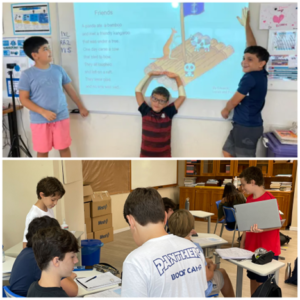EARJ’s road to the IB Primary Years Programme

It was during a university tour in Newcastle, UK, that my youngest daughter excitedly said to me, “Mom, this is the one! This is the program I want to study.”
After 6 university tours and what felt like an endless number of kilometers driving around the UK, she had made the decision that best suited her dreams and aspirations. She wanted to work in a creative field, utilizing the skills she’d developed during her IB Middle Years Programme and IB Diploma Programme years and she felt strongly it was in advertising.
The level of confidence she displayed in her decision surprised me. This was not my normal 17-year-old who rarely remembered to take out the garbage or moaned when asked to take the family dog on a walk. No, this excited teenager was piecing together what would become the next 4 years of her life. I realized then what the last 5 years as an International Baccalaureate (IB) student had nurtured; a student who knew herself as a learner and knew what she wanted from her university experience.
She completed her degree in advertising and then went on to complete a Master’s degree in digital marketing. I owe a debt of gratitude to the IB World School she attended and the teachers who supported her along the way.
As an IB educator and an IB parent, I’ve experienced firsthand what an IB education can offer a student and their family. This year, EARJ will officially begin its candidacy in the Primary Years Programme (PYP). In the coming years, a Middle Years Programme candidacy will follow to align with the existing Diploma Programmes offered on both campuses. The development of an EARJ roadmap to become an authorized 3-programme IB World School started some time ago and has not wavered in its strategic intent to have EARJ offer:
“an internationally recognized curriculum that is philosophically consistent, vertically aligned, academically rigorous, and which provides high quality learning pathways for students to pursue their passions and access the best possible university opportunities”.
This strategic intent will strengthen the school’s focus on students and how best to create learning experiences that encourage them to think critically and challenge assumptions in a globally changing world. As an American international school, it will encourage students to think about and through local and global contexts. Language will be enhanced as IB programmes develop multilingual students.
Teaching and learning in an IB World School prepare students for their future. When my daughter toured university campuses and listened to various program descriptions, she knew herself well enough to know that she preferred a program that was case-study based, heavy on conversation and debate, and focused on projects. She wanted to be an active learner, questioning the status quo, and working with innovative thinkers.
Much of what she was looking for, she experienced with her fellow IB classmates. That is why I think she had such a strong reaction when we toured her final university. It fit her best as a learner and how she wanted to spend her time learning. To have that understanding of self at a young age is because IB programmes instill a belief that students are the holder of their own learning. It starts with our very young learners in the PYP and progresses through the other IB programmes. According to all IB programmes, teaching is:
-
Based on inquiry. A strong emphasis is placed on students finding their own information and constructing their own understandings.
-
Focused on conceptual understanding. Concepts are explored in order to both deepen disciplinary understanding and to help students make connections and transfer learning to new contexts.
-
Developed in local and global contexts. Teaching uses real-life contexts and examples, and students are encouraged to process new information by connecting it to their own experiences and to the world around them.
-
Focused on effective teamwork and collaboration. This includes promoting teamwork and collaboration between students but also refers to the collaborative relationship between teachers and students.
-
Designed to remove barriers to learning. Teaching is inclusive and values diversity. It affirms students’ identities and aims to create learning opportunities that enable every student to develop and pursue appropriate personal goals.
-
Informed by assessment. Assessment plays a crucial role in supporting, as well as measuring, learning. This approach also recognizes the crucial role of providing students with effective feedback.
I am proud to be part of EARJ’s PYP candidacy. There will be work to do, but as I experience the EARJ spirit and observe a strong commitment to student learning, I believe the PYP will deepen what is already a strong foundation in learning, in addition to strengthening our internationally-minded community. Let’s go on this IB journey together!
For more information on the International Baccalaureate programmes, visit: www.ibo.org
Doreen J. Garrigan
Gávea Lower School Principal



